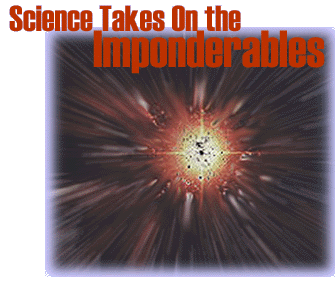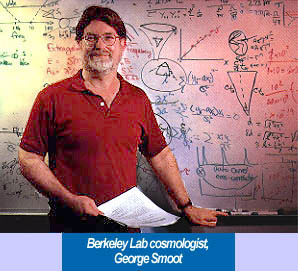ETERNAL MYSTERIES:

by Jeffery Kahn | The earth is flat. The sun dies every night, and every morning is reborn. The earth is at the center of the universe, and all things near and far revolve around the earth . . . or so people once thought.
Over the past 500 years, one by one, these central beliefs about our planet have been set aside. Driven by the human need to know, generations of discoverers and explorers have mapped the Earth and its place in the firmament. Now, a similar revolution is unfolding, expanding our understanding of a larger world, the universe itself.
What is the origin and fate of the universe? What are the fundamental laws of nature that have existed since the beginning of time? These are the eternal mysteries, questions that are as old as human curiosity itself. Many cultures and civilizations have studied the heavens and constructed creation stories, but these age-old questions have remained essentially beyond the limits of human knowledge and understanding.
 Now, many in the scientific community
believe that has changed. Researchers, among them Berkeley Lab
cosmologist George Smoot, say civilization has arrived at a momentous
time. "People have contemplated the origin and evolution of the
universe since before the time of Aristotle," says Smoot. "Although
cosmology has been around since the time of the ancients, historically
it has been dominated by theory and speculation. Very recently, the era
of speculation has given way to a time of science. The advance of
knowledge and of scientific ingenuity mean that at long last, we can
actually test our theories."
Now, many in the scientific community
believe that has changed. Researchers, among them Berkeley Lab
cosmologist George Smoot, say civilization has arrived at a momentous
time. "People have contemplated the origin and evolution of the
universe since before the time of Aristotle," says Smoot. "Although
cosmology has been around since the time of the ancients, historically
it has been dominated by theory and speculation. Very recently, the era
of speculation has given way to a time of science. The advance of
knowledge and of scientific ingenuity mean that at long last, we can
actually test our theories."
Early in the 20th century, science produced a theory on the origin of the Universe which its detractors scornfully termed the "Big Bang." Since that time, the Big Bang repeatedly has been subjected to the test of science, and thus far has met that test. A broad range of evidence supports the theory, but perhaps the most powerful is cosmic microwave background (CMB) radiation. For those exploring the hidden story of our universe -- questions concerning its beginnings, how and why it has assumed its present shape, and its ultimate fate -- the CMB is the motherlode. Among the swelling ranks of cosmologists, a CMB gold rush has begun.
The CMB has been called "the message from the beginning of time." Its roots go back to the Big Bang itself, the primeval explosion that began the universe when all that we observe today was compressed in a volume smaller than a proton. According to theory, prior to the Big Bang space and time did not exist. And so the Big Bang did not occur in one place and then spread out like some kind of fireworks display. Instead, it happened everywhere at once. All space, which began to expand at the moment of the Big Bang, was equally pervaded with the physical contents produced by the leviathan explosion. That includes the relic radiant energy from this explosion, the CMB. To this day, CMB radiation saturates all of space throughout the universe. In fact, at any given instant, every cubic meter of space is bathed in some 400 million photons of CMB radiation zipping through at the speed of light.
The CMB is pregnant with clues as to the evolution of the universe. Smoot says that is because the evolution of the universe is effectively synonymous with the change in spatial distribution of matter through time -- starting from virtual equal distribution in the early universe and evolving to the very lumpy universe of today, with matter clustered as galaxies, clusters of galaxies, superclusters, and even larger groupings. Imprinted within the CMB is the pattern of the distribution of matter created shortly after the beginning of time. It is a pattern that reveals the newborn shape of the universe and a blueprint that dictates its future.
Scientists began looking for this pattern shortly after the CMB was discovered in 1964. Bell Lab scientists found a low-level microwave hum that pervades the cosmos and that was extremely smooth and uniform in all parts of the sky. This hum, which came to be known as the CMB, had been predicted by the Big Bang theory. However, the theory also requires slight variations in the CMB. Theory indicates that the very early universe must have had fluctuations in temperature and density on the order of one part in 100,000. That would be sufficient for gravity, working over billions of years, to magnify perturbations of this magnitude into the clusters of matter we observe in today's universe. In 1992, the COBE satellite team headed by Smoot announced the historic discovery of these extremely slight variations in the CMB. As Smoot explained, these variations are the primordial seeds that grew into the galaxies and superclusters of galaxies evident today.
How can scientists deduce the past and future shape of the universe from the CMB? Smoot likened the process to a doctor reading a sonogram.
 "With a sonogram," he said, "a doctor
sends out sound waves and creates a reflected image of an unborn baby.
In cosmology, we have sound waves produced by perturbations in the
early universe. Quantum mechanics dictate that the early universe had
these fluctuations in energy density. As the universe expands, these
fluctuations ripple out and become oscillations that have profound
influences on the shape and the destiny of the universe. When you hit a
bell with a hammer, the bell rings at all frequencies. But the nature
of the bell determines particular frequencies or tones that are picked
out and which continue to sound. Here, we have a tap on the universe.
In effect, the CMB provides a sonic image of the infant universe."
"With a sonogram," he said, "a doctor
sends out sound waves and creates a reflected image of an unborn baby.
In cosmology, we have sound waves produced by perturbations in the
early universe. Quantum mechanics dictate that the early universe had
these fluctuations in energy density. As the universe expands, these
fluctuations ripple out and become oscillations that have profound
influences on the shape and the destiny of the universe. When you hit a
bell with a hammer, the bell rings at all frequencies. But the nature
of the bell determines particular frequencies or tones that are picked
out and which continue to sound. Here, we have a tap on the universe.
In effect, the CMB provides a sonic image of the infant universe."
The mapping of the CMB and the mining of the information it contains has just begun. The COBE satellite team mapped the CMB at the large scale, imaging slices of the sky equivalent to 14 Moon diameters. Though its instruments were the first sensitive enough to see the primordial variations in the CMB, the maps produced were low resolution. COBE was only able to map fluctuations that are more than 100 million light years across, or structures far larger than the supercluster to which our Milky Way galaxy and its Local Group of galaxies belongs. Theorists believe that at smaller scales there is much greater variation, much more detail in the CMB. Numerous scientific teams around the world including several here at Berkeley Lab are racing to invent and deploy instruments to map the CMB at these smaller scales. From the scale mapped by COBE, they must zoom in four to five hundred times closer to see the irregularities that would give rise to galaxies. To this day, galaxy formation -- at what stage galaxies began forming, why and how they happen -- remains a fundamental mystery.
Another object of desire among cosmologists is the density of the universe. Once the density is known, the rate of expansion of the universe (Hubble constant) can be deduced. Since the Big Bang, the universe has been expanding. Will it continue expanding forever, or one day lose momentum, reverse course, and ultimately collapse upon itself in a fiery finale? Within the CMB is hidden the answer to these eternal questions.
For Smoot, the quest for the fundamental laws of nature is the ultimate prize of CMB cosmology. "The goal is to reduce the current physics to simpler, more elegant underlying principles. The conviction that these underlying principles exist has long been an article of faith among particle physicists, and now it is becoming a shared belief of cosmologists. When we discover these underlying principles, we may then understand how space and time formed out of nothing. We will understand why space-time has four dimensions. And we'll understand how the laws of physics evolved from the instant of creation."
All these questions, the grand mysteries of the universe, have existed since the emergence of human curiosity. Not to simply believe, but rather to know -- perhaps that is the very essence of human destiny. Here at the end of the 20th Century, we may dare to believe that people can know and comprehend what heretofore has been off limits to the human mind.
